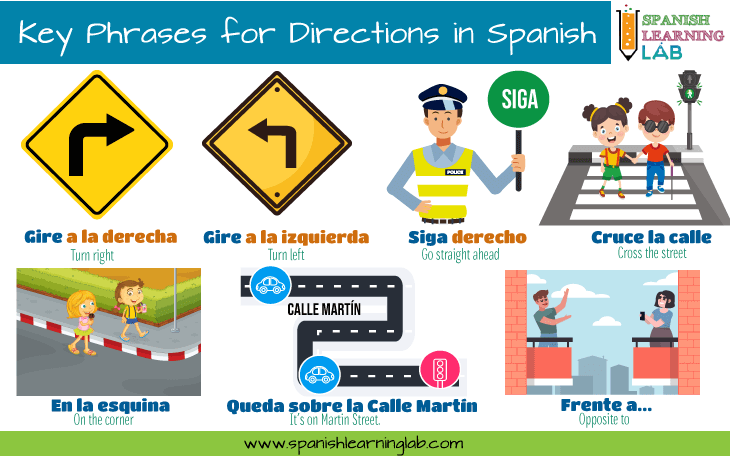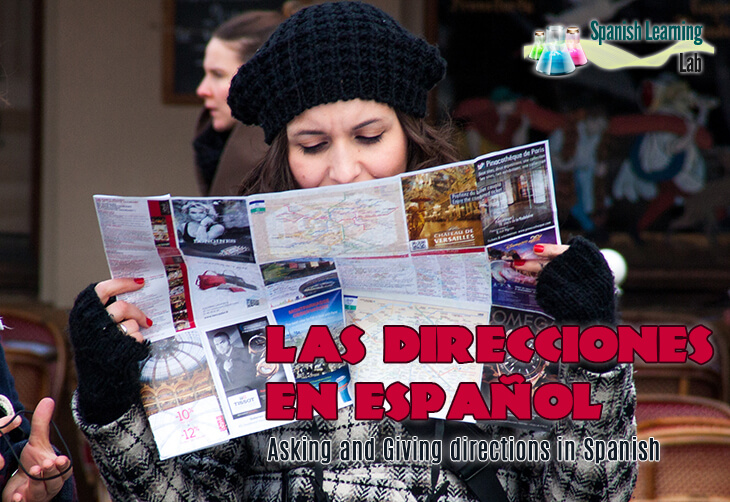
In a previous lesson, we learned part of the vocabulary for places in town. We also discussed a little about different ways to ask and give directions in the language. This lesson will focus on introducing some new phrases and contextualize the vocabulary in conversations where people need to ask or give directions in Spanish. As usual, we have included a nice video, many examples, listening activities and interactive quizzes. Let’s start…
This video will introduce different ways to ask for directions in Spanish, the basics about prepositions of place to indicate the location of places in town, and how to use the verbs ESTAR, QUEDAR and the form HAY from the verb HABER. It also explains how to use some phrases that will be part of the sample conversations, such as: “Siga” (Go on), “A la izquierda” (to the left) and others. Make sure to stick until the end of the video and then solve the interactive quiz about it.

Here is the first conversation about directions using the expressions and questions that we have presented so far, plus some new ones.
Alika: Vicente, where is the bank?
Vicente: The bank is in front of the San Judas hospital
Alika: Thank you! I have to go to the bank right now.
Vicente: Well, if it is closed, there is another bank next to the Estrella pharmacy.
Alika: Thanks! Then I’ll go to the bank that is near the San Judas hospital
Vicente: Okay! Good luck!
Carlos Roberto, where is this restaurant?
Roberto: mmm … let me see … It is on central street, opposite to Hotel Villa.
Carlos: Hotel Villa? I have no idea where that is.
Roberto: You do not know. It’s okay. Let’s look at the map.
Carlos: Let’s start with central street.
Roberto: To get to central street, take bus No. 1 and get off at the police station. Then walk two blocks north.
Carlos: Is this the restaurant?
Roberto: No, not this. When you reach the Italian restaurant, turn right and walk about 50 meters to get to Hotel Villa.
Carlos: I understand. The restaurant is across the street then.
Robert: Exactly!
When you have no idea where a specific place is located, then you can use the phrase “No sé dónde queda” or “No sé dónde está”. If you want to confirm the location of place, just change the intonation of your sentence and make it sound like a question, just like in these examples: “¿El cine queda aquí?” (Is the cinema here?) and “¿El restaurante está al cruzar la calle?”. (Is the restaurant across the street?)
The second example will show other words and phrases for giving directions in Spanish. This conversation is more polite and includes the verbs “Saber” (to know), “Perderse”(to get lost), “caminar” (walk), “pedir” (ask for) and “haber”. You can tell people to walk straight ahead by using the phrases “camina derecho” or “camina en esta calle”. You could use phrases such as “a la derecha”(to the right), “a la izquierda” (to the left) and prepositions like close (cerca) or far away (lejos). Listen to the sample conversation and check how they use some of these expressions for asking and giving directions in Spanish.
Miguel: Excuse me, do you know where the bus station is?
Claudia: Yes, it is near here. Just walk straight for 2 blocks, then turn right and then walk for 1 more block. The station is right in front of an elementary school.
Michael: Thank you. What other places are there near the station?
Claudia: There is a supermarket and several shops. Do not worry, it’s easy. If you get lost, you can ask for help at the police station that is also nearby.
Michael: Thank you for your help, I hope not to get lost.
Claudia: You’re welcome. Good luck.
Carlos: Where is the nearest pharmacy?
Ana: It’s on Calle Aurora, right next to a dental clinic ,and in front of the gas station.
Carlos: Thank you. Yesterday I was there, but I didn’t see any pharmacy.
Anna: Really? How odd. Maybe they moved it to another place. Let’s check.
Carlos: Yes, we better double-check the address before heading there.
Anna: Yes, look. They are now located on Calle Diamante, near this park that appears on the map.
Carlos: Is that the street where the hospital is located?
Anna: That same one. You can take a bus, you get off in front of this bank, and then you walk two blocks south. Look, there is also a supermarket and several restaurants near the pharmacy.
Carlos: Thanks, I’m sure of the address of the place.
Listen to a short conversation about places and directions in Spanish. Take notes of what you hear in the recording and pay attention to the way the vocabulary and expressions presented in the lesson are used. Press PLAY when you are ready.

Brenda: Mercedes… Estoy buscando la dirección del restaurante “Delicias” ¿Sabes dónde queda?
Mercedes: Sí, yo fui a cenar con mi novio a ese restaurante la semana pasada. Está ubicado frente al hospital. Es un edificio grande, de color azul y blanco.
Brenda: y ¿Cómo es el lugar?
Mercedes: ¡Es muy bueno! Nosotros pasamos bastante tiempo ahí y comimos un pescado delicioso…
Brenda: ¿De veras? ¿Hay otros lugares interesantes cerca del restaurante?
Mercedes: Sí, hay un parque a dos cuadras al sur del restaurante y un teatro a media cuadra al norte.
Brenda: Parece que es un buen lugar después de todo.
Mercedes: A mí me gustó mucho Brenda.
Read the lines of this conversation carefully. It includes much of the vocabulary and structures in the lesson. Then, press “Check” when you finish moving the lines up and down.
Think about the following questions and then write their answers and read them out loud to practice your pronunciation.